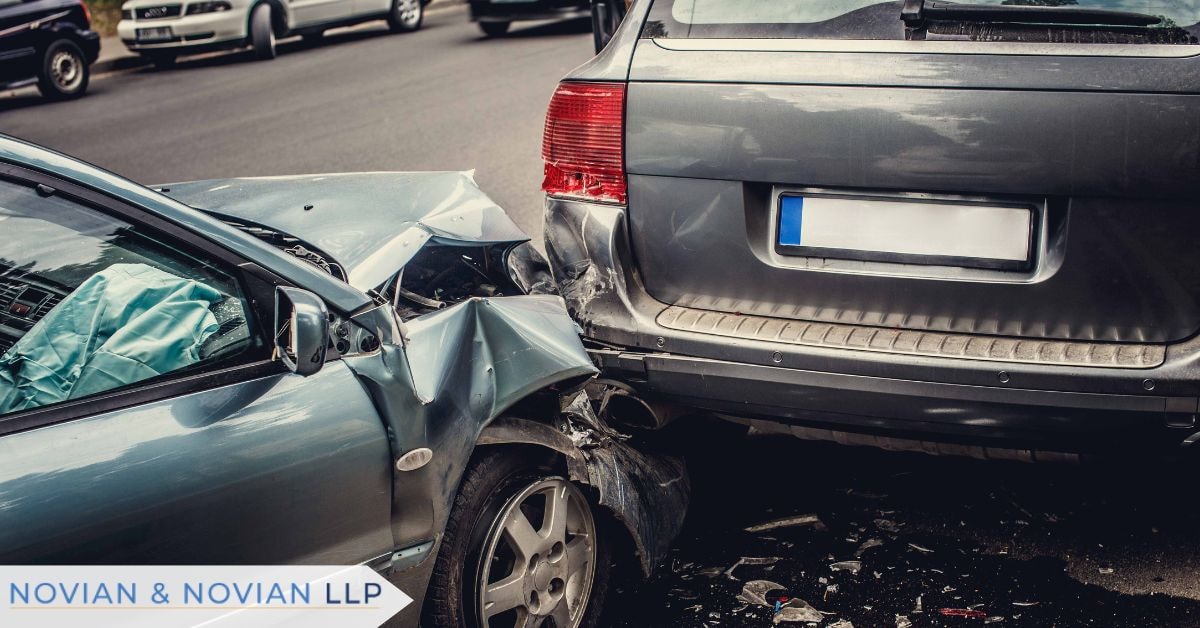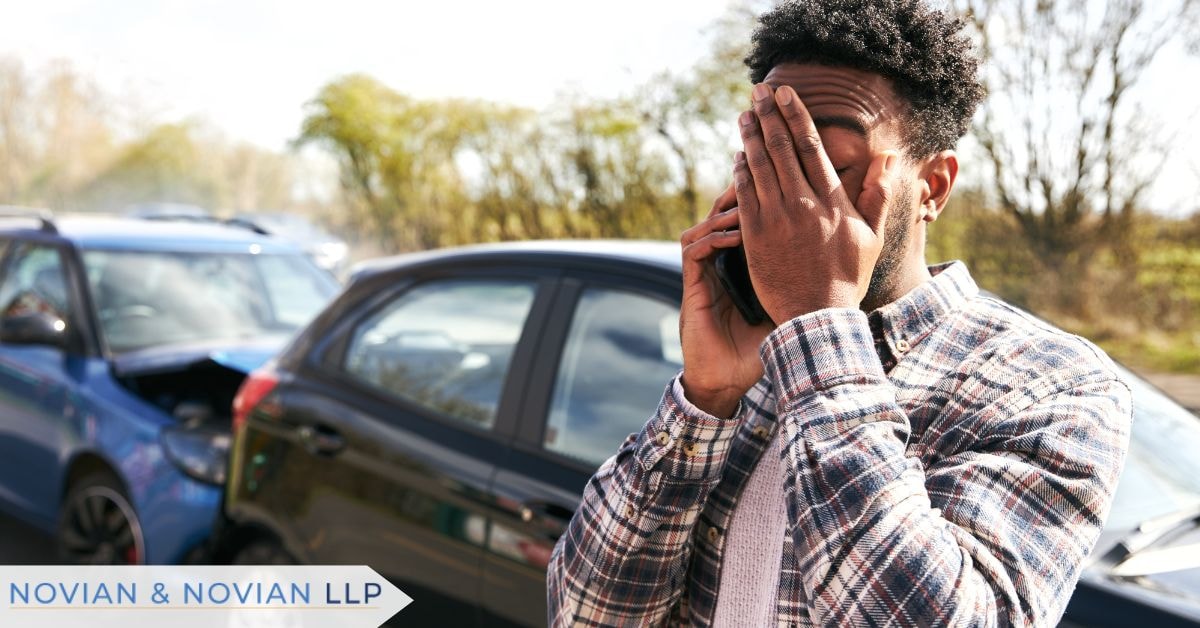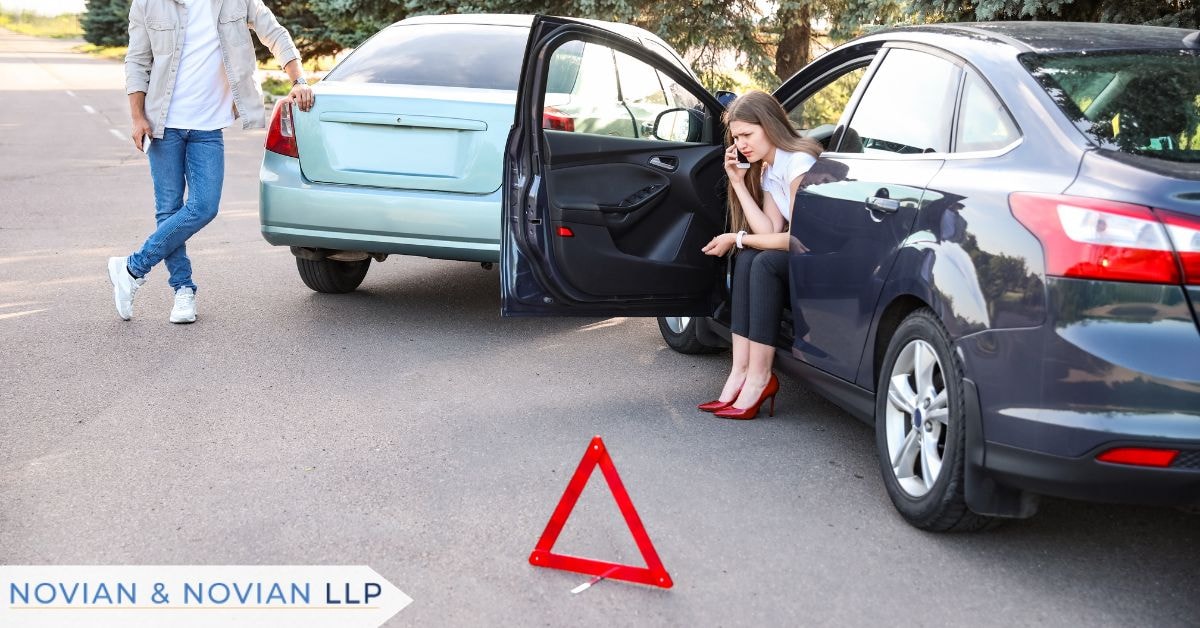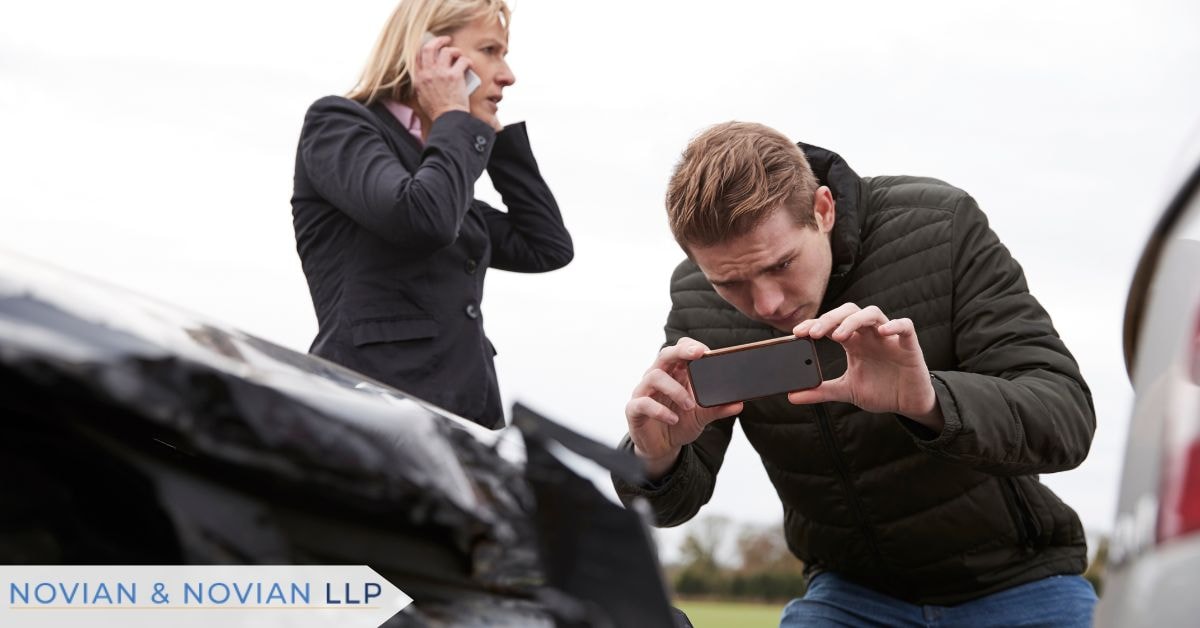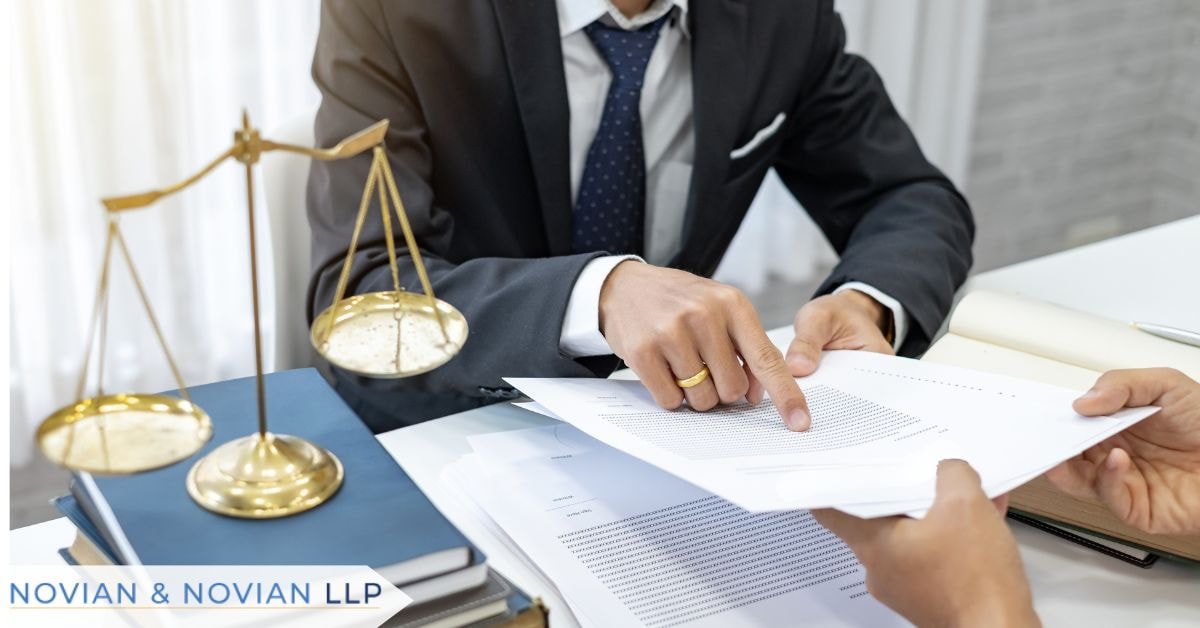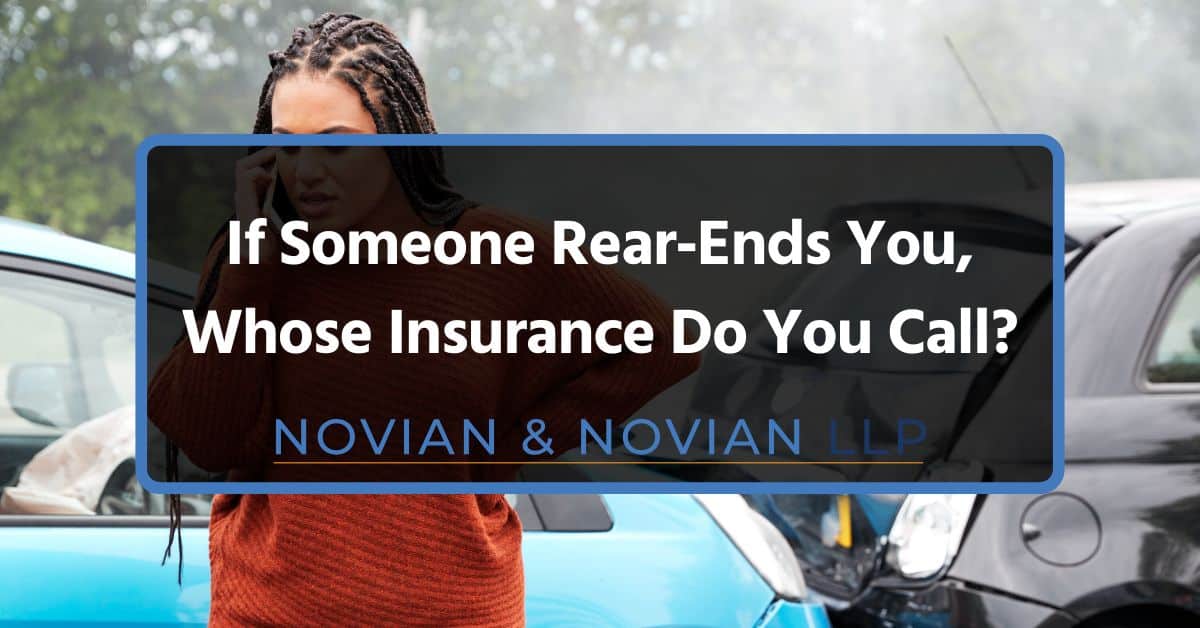
By | Jan 27, 2025 | Catastrophic Injury
When you are involved in a rear-end accident, you are most likely to be overwhelmed with many expenses, including healthcare expenses. In such situations, you will need to cushion the expenses, which is where insurance comes into play. But whose insurance do you call?
If someone rear-ends you, you should typically call their insurance company to file a claim, as they are usually considered at fault in rear-end collisions. Additionally, you should notify your own insurance company to ensure they are aware of the incident and can assist if necessary.
If you’ve been rear-ended and need legal advice, Novian & Novian can help you. Our California rear-end injury lawyers have over 35 years of experience dealing with catastrophic injuries, and can help you get the compensation you deserve. Contact us today for a free consultation.
This post will serve as a guide on the steps to take immediately after a rear-end collision. We will also share tips for simplifying the claims process.
What Is a Rear-End Collision?
A rear-end collision occurs when one vehicle crashes into the back of another. According to the National Highway Traffic Safety Administration, rear-end collisions account for nearly 30% of all car accidents annually.
These accidents are among the most common types of car accidents and often result from distracted driving, sudden stops, or a failure to maintain a safe following distance. Rear-end collisions can range from minor fender benders to serious crashes causing significant injuries or damage.
Who Is Usually at Fault?
In most cases, the rear driver is considered at fault in a rear-end collision. This principle is based on the common expectation that drivers should maintain a safe following distance to avoid hitting the vehicle in front of them. Traffic laws emphasize the need for this safe distance to ensure that drivers can stop in time, even during sudden traffic changes.
The concept of “following too closely,” often referred to as tailgating, is a violation of traffic laws in many jurisdictions. When a driver follows another vehicle too closely, they reduce their reaction time and increase the likelihood of a rear-end accident. As a result, insurance providers, law enforcement, and courts typically hold the rear driver responsible for such accidents.
While the rear driver is usually at fault, there are exceptions where they might not bear the responsibility. For instance, if the front driver makes an abrupt and unnecessary stop, known as a brake check, or stops suddenly without a valid reason, the fault could shift to them. Similarly, unforeseen circumstances like sudden mechanical failures, multi-car pile-ups, or collisions caused by external factors can complicate fault determination. In such cases, insurance companies and legal representatives often conduct thorough investigations to determine liability.
If Someone Rear-Ends You, Whose Insurance Do You Call?
Being involved in a rear-end collision can be overwhelming, especially if you’re unsure about the claims process. Whether you contact your own insurance provider or the other driver’s insurance company depends on the specifics of the car accident, including who is at fault and the type of coverage you have.
When to Contact Your Own Insurance Company
Even if you are not at fault, it is important to notify your own insurance company after a rear-end collision. This step ensures that they are aware of the incident and can assist with your claim if needed. Your insurer may provide personal injury protection (PIP) benefits, medical payment coverage, or assistance with vehicle repairs if the at-fault driver’s insurance company delays or denies payment.
When reporting the incident to your own insurance provider, be prepared to provide specific details about the accident. This includes the time and location of the crash, a description of the accident scene, the other driver’s insurance information, license plates, and the police report number. If possible, share photos of the collision, vehicle damage, and any injuries to strengthen your claim.
When to Contact the Other Driver’s Insurance Company
In most rear-end accidents, the at-fault driver’s insurance company is responsible for covering damages and medical expenses. You will need to file a claim with their insurer to recover damages for vehicle repairs, medical care, and other related costs. If the other driver admits fault or liability is clear, their insurance provider will typically handle the claims process on behalf of their policyholder.
However, in some cases, both drivers may share responsibility for the accident. In states with comparative or contributory negligence laws, the fault may be divided based on the circumstances of the crash. For example, if the lead driver made a sudden stop or failed to use proper signals, they might be partially at fault. In such cases, the amount of compensation you can recover from the other driver’s insurer may be reduced by your percentage of fault.
Immediate Steps to Take After Being In A Rear-Ended Car Accident
Here are the immediate steps to take after being involved in a rear-end car accident:
- Ensure Safety First
Your first priority after a rear-end collision should be the safety of everyone involved. Check for injuries, assessing yourself and your passengers for any signs of harm. If anyone is injured, call 911 immediately to request medical attention.
Even if injuries seem minor, seeking immediate medical care is necessary since some conditions, like whiplash or internal injuries, may not present symptoms right away. Furthermore, move your vehicle to a safe location, such as the side of the road, to avoid further accidents and ensure traffic can flow safely. Turning on your hazard lights will also help alert other drivers to the situation.
- Call the Police
Regardless of how minor the damage may appear, contacting the police is essential. A police report provides an official record of the car accident, which can be invaluable for your insurance claim or legal proceedings.
It is important to make sure to request a copy of the accident report for your records. This document will include key details such as the officer’s observations, any traffic violations, and whether the rear driver is at fault.
- Check for Damages
Once everyone’s safety has been ensured, you need to assess the damage to your vehicle. Look for visible dents, scratches, or other signs of collision-related issues. If possible, take photos of the damage for use in the claims process.
It is necessary to be thorough in your documentation, including images of the other driver’s vehicle, the accident scene, road conditions, traffic signs, skid marks, or debris. These details will be critical in determining fault and supporting your insurance claim.
- Gather Information
Another necessary step is exchanging information with the other driver. You should collect their full name, contact details, insurance provider information, driver’s license number, and license plate number.
If there are any witnesses to the accident, ask for their contact information. Their statements can be helpful if the fault is disputed. Document the scene thoroughly with photos from multiple angles, ensuring you capture the position of the vehicles and any relevant road or traffic conditions.
- Do Not Admit Fault
It is important to avoid making any statements that could imply fault for the accident. When speaking with the other driver, the police, or your insurance company, stick to the facts.
Admitting fault at the scene can complicate the claims process and might be used against you later. Let insurance adjusters, attorneys, or law enforcement determine liability based on the evidence.
- Notify Your Insurance Company
Contact your insurance provider as soon as possible to report the collision. Even if the other driver is clearly at fault, notifying your insurer allows them to assist with your claim and provide coverage for immediate needs, such as vehicle repairs or rental car reimbursement.
Provide your insurance company with all the gathered information, including the police report number, photos of the accident scene, and the other driver’s insurance details. If the crash involved significant damages or medical expenses, initiate the claim process promptly.
What Happens if the At-Fault Driver Is Uninsured or Underinsured?
Sometimes, you may find yourself in a car accident with an at-fault driver who is either uninsured or underinsured. Uninsured motorist coverage is designed to protect you when the at-fault driver has no insurance. This type of coverage typically kicks in to cover medical expenses, lost wages, and damages to your vehicle that the at-fault driver’s insurance would have paid.
Underinsured motorist coverage, on the other hand, applies when the at-fault driver’s policy limits are insufficient to cover the full extent of your damages. In these cases, your own insurance can step in to bridge the gap between the at-fault driver’s coverage and your actual costs.
The primary difference between uninsured and underinsured motorist coverage lies in the at-fault driver’s level of insurance. If the at-fault driver has no insurance at all, uninsured motorist coverage applies. If the at-fault driver has some coverage but not enough to fully compensate you, underinsured motorist coverage will help cover the remaining costs.
There are also optional insurance policies, such as comprehensive and collision coverage, that can provide additional financial protection in the event of an accident with an uninsured driver. Comprehensive coverage pays for damages to your vehicle caused by non-collision events like theft or natural disasters, while collision coverage applies to damages resulting from an accident, regardless of fault.
Having these policies in place ensures that you can recover financially even if the at-fault driver is uninsured or underinsured. While these coverages may increase your premium, they offer invaluable peace of mind, especially if you live in an area where uninsured drivers are common.
Tips for Simplifying the Claims Process
To simplify the claims process, you should keep detailed records of all communications. This includes communication with insurers, repair shops, and even medical providers. This documentation will support your claim and help avoid misunderstandings.
Understanding the details of your policy is equally important. You need to familiarize yourself with the types of coverage you have, such as collision, medical payments, and liability insurance. Knowing what your policy covers will help you manage expectations and take appropriate steps when filing a claim.
If the claims process becomes overwhelming or if disputes arise, consulting with a personal injury attorney may be beneficial. An experienced attorney can guide you through the process, negotiate with insurance companies, and ensure that you receive the compensation you deserve.
What if the At-Fault Driver’s Insurance Denies My Claim?
If the at-fault driver’s insurance denies your claim, you still have options. Start by reviewing the denial letter carefully to understand the reasons for the refusal. Sometimes, claims are denied due to lack of evidence, policy exclusions, or disputes over liability. Gathering additional evidence, such as witness statements or expert opinions, can strengthen your case.
In some cases, you may need to file a claim with your own insurance under your uninsured or underinsured motorist coverage. If negotiations with the insurer fail, pursuing legal action may be necessary. Hiring a personal injury attorney can be helpful in ensuring that your rights are protected and that you recover the compensation you’re entitled to.
In Need of Personal Injury Protection?
Being involved in an accident is a stressful experience, but knowing how to handle the aftermath can make all the difference. You should prioritize safety, carefully document the scene, and understand who to contact for assistance. These steps not only help protect your health and well-being but also ensure you are better positioned to pursue a fair resolution for your case.
You need to understand the role of insurance, whether it involves personal injury protection or claims against the at-fault driver’s policy. If you are unsure about the process, consulting a personal injury attorney can help you navigate complex insurance and legal matters while advocating for your rights.
Novian & Novian is here to support you through this challenging time. With a proven track record and expertise in personal injury law, we have personal injury attorneys in California who can help you secure the compensation you deserve. Schedule a free consultation with us today!
Contact Us
Have questions about this post? Novian & Novian is a full service law firm in Los Angeles with clients that span the country. Contact us today for a free consultation.
Contact Us
Have questions about this post? Novian & Novian is a full service law firm in Los Angeles with clients that span the country. Contact us today for a free consultation.
